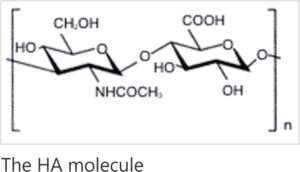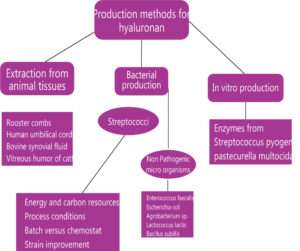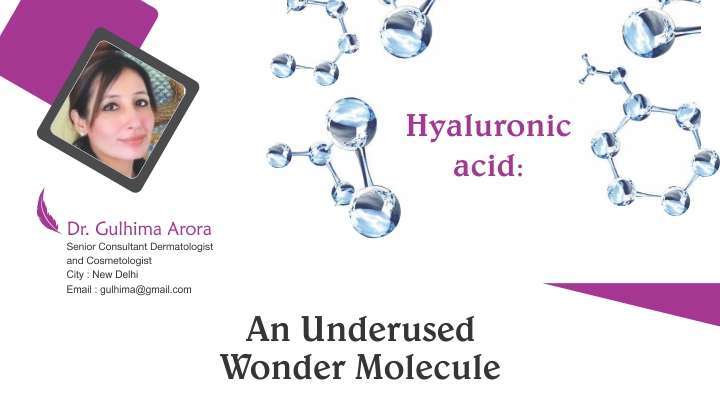Hyaluronic acid (HA) is a very versatile molecule, with a ubiquitous presence in the human body.
It is found in the vitreous humour of the eye, the synovial fluid, extracellular matrix, bones, cartilage, umbilical cord, neural tissue and most importantly, the skin, where 50% of the total body HA is.
CHEMISTRY AND PHYSIOCHEMICAL PROPERTIES:
HA is a nonsulfated glycosaminoglycan, a polymer of disaccharides, present in the extracellular fluid. Polymers of hyaluronic acid can range from 5,000to 20,000,000 Da in vivo. It thus has a high molecular mass. It is present in all vertebrates, with the rooster comb containing the highest concentrations ever reported in animal tissues. It is also present in the capsules of microorganisms.
A 70kg adult has approximtely 15g of HA.

PHYSIOLOGICAL FUNCTION IN THE SKIN:
The biological functions of hyaluron are related to the size of the molecule. Higher weight polymers cause immunosupperssion, filling (dermal fillers) and are antiangiogenic. Medium-sized polymers help in wound healing. The oligosaccharides are infammatory, immuno-stimulatory and angiogenic. The smallest polymers (400to4000Da) are antiapoptotic.
Hyaluronic acid is the major molecule that maintains hydration in the skin.
1g binds with 6L of water.
The human body has approximately 15g of hyaluronoc acid, one-third of which is “turned over” every day.
It is responsible for maintaining the turgor, elasticity and hydration of the skin.
It plays an important role in the synthesis of ECM molecules and in epidermal cell interaction.
It aids in wound healing and reduction of inflammation as mentioned above.
It modulates cellular immunity by preventing infections and reducing the chance of allergies.
It maintains the tissue homeostasis.
It acts as an immune regulator in human diseases.
It is highly biocompatible; and this property has made it a ubiquitously used wonder molecule.
SYNTHESIS OF HYALURONIC ACID:
In living organisms, it is synthesised by hyaluron synthtase enzymes.

DEGRADATION OF HA
It has a dynamic turnover rate, with a half-life of less than a day in the skin. It is degraded by enzymes called hyaluronidases. It can also be degraded non-enzymatically by free radical mechanism, in the presence of ascorbic acid, ferrous or cuprous ions in the presence of oxygen.
Hyaluronic acid gets depleted with age.
Substances with polysaccharide-like structure have inhibiting effects on the degredation of HA by competing with it.Cross linking helps to prevent degredation to some extent.
It gets washed off with water and has to be re-applied.
HA and the SKIN
Hyaluronic acid is that wonder molecule, which keeps the skin firm, supple and hydrated. It maintains the moisture balance of the skin, and maintains the skin health.
It can adjust the moisture absorption rate based on the humidity in the environment. It thus maintains the skin health.
It is an important anti ageing molecule. It is used for fine lines on the skin.
Hyaluronic acid is said to have antioxidant and free radical scavinging activities.
It protects the skin from UVB rays.
HA is said to decrease the lipid concentration in the sebaceous glands.
HA AND WRINKLES
Hyaluronic Acid as an antiageing requires special mention. It combines with the keratin of the skin via hydrogen bridges in a water leaves a tension in the skin, which obliterates the fine wrinkles.
ENHANCING PENETRATION OF HA
Shorter chain polymers are better absorbed by the horny layer of the skin. Using an electroporation or ultrasound with itenhances the breakdown into shorter chains. Combining HA with a matrix of dextrin or modified cellulose too helps.
TYPES OF HYALURONIC ACID PRODUCTS
The biggest advantage of this molecule is that it can penetrate the upper skin layers and cross the skin barrier and it is an inert molecule.
The various forms available are
- Serums
- Creams
- Oral supplements
- Dermal cross-linked fillers (pre-filled syringes)
- Auto cross-linked hydration syringes
- As a powder for consumption
- As an ingredient in mouth washes
THE FUTURE OF HA MOLECULE
The commercial value of hyaluronan is huge. It is sold for about 1,00,000 USD per Kg! The world market is around 500million USD. It is being used for diverse applications. It is already being used for cancer therapy. With newer insights into production techniques, and knowledge about is biological functions, this wonder molecule is here to stay, and being researched more and more to be put to therapeutic use. Nanoparticles and liposomes of hyaluronic acid are being developed to enhance its penetration.






